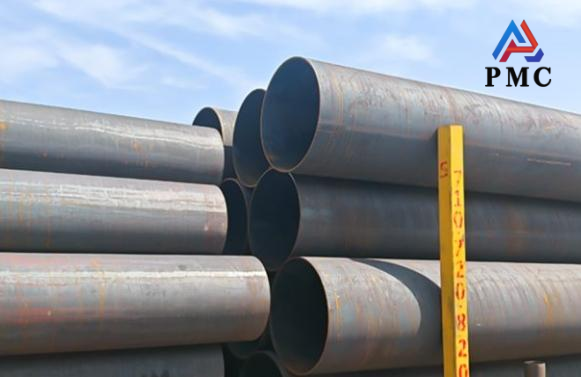
Seamless Carbon Steel Pipe vs Seamless Alloy Steel Pipe
Seamless steel pipes are essential for conveying fluids and gases in environments involving high pressure, elevated temperatures, or corrosive conditions. Among the most commonly used types in industrial settings are Seamless Carbon Steel Pipes and Seamless Alloy Steel Pipes. Knowing the differences between them is key to choosing the appropriate pipe for a given application.
Material composition
Seamless Carbon Steel Pipe: Primarily composed of iron and carbon, with carbon content typically ranging from 0.1% to 0.3%. It may contain small amounts of elements like manganese, silicon, and copper, but no significant alloying elements. The focus is on providing strength and ductility at a lower cost. Typical materials are: 20#, 45#, Q235, ASTM A106, ASTM A53, etc.
Seamless Alloy Steel Pipe: Made from carbon steel with the addition of alloying elements such as chromium, molybdenum, nickel, vanadium, and others. These elements are added in specific proportions to enhance properties like strength, hardness, corrosion resistance, and high-temperature performance. Typical materials are: 15CrMo, 12Cr1MoV, P91/P92, 304/316 stainless steel, ASTM A333 Gr.6, etc.
Mechanical properties
Seamless Carbon Steel Pipe: It provides reliable strength, ductility, and toughness for a wide range of general applications. It is suitable for moderate pressure and temperature environments. However, its performance decreases at higher temperatures, and it does not offer strong resistance to creep or oxidation.
Seamless alloy steel pipe: It is designed to deliver superior mechanical performance. The inclusion of alloying elements greatly enhances its tensile strength, hardness, and resistance to wear, creep, and fatigue. It retains its structural stability under extreme pressure and temperature conditions, making it ideal for demanding and high-performance applications.

Manufacturing process
Seamless Carbon Steel Pipe: Typically produced using hot rolling or cold drawing techniques. The process begins with a solid billet, which is heated and pierced to form a hollow tube. It is then rolled or drawn to the desired size. The focus is on efficient production with good dimensional accuracy for general-purpose applications.
Seamless Alloy Steel Pipe: Manufactured through a similar seamless process (hot rolled or cold drawn), but with stricter control over temperature and chemical composition due to the presence of alloying elements. Additional heat treatment processes such as quenching, tempering, or annealing are often applied to achieve the required mechanical properties for high-performance applications.
Prices vary greatly
Seamless Carbon Steel Pipe: Because seamless carbon steel pipe is primarily made from common carbon steel, which is widely available and produced using a relatively conventional process, its price is relatively affordable, generally ranging from 4,000 to 6,000 yuan per ton. In projects with strict cost controls and less stringent performance requirements, such as plumbing for general construction, seamless carbon steel pipe, due to its price advantage, has become the preferred choice.
Seamless Alloy Steel Pipe: Seamless alloy steel pipes contain a variety of expensive alloying elements, such as chromium, nickel, and molybdenum. These elements are expensive to obtain, significantly increasing raw material costs. Furthermore, the production process is more complex, requiring higher standards for production equipment and technology. This results in a relatively high price for seamless alloy steel pipes, typically ranging from 8,000 to 12,000 yuan per ton, or even higher. Despite the high price, seamless alloy steel pipes are widely used in fields such as petrochemicals and aerospace, where steel pipe performance is extremely demanding, due to their ability to meet the demands of specialized working conditions.
Application areas
Due to its low cost and ease of processing, seamless carbon steel pipes are widely used in industrial and construction applications for general piping and structural components where corrosion resistance is not a priority. In the construction industry, seamless carbon steel pipes are used to construct scaffolding, building frames, and other structures, providing stable support. In machinery manufacturing, they are used to manufacture mechanical parts and general piping with relatively low performance requirements, such as drive shafts for machine tools and ventilation ducts in factories.
Due to their superior performance, seamless alloy steel pipes are primarily used in fields with stringent requirements for steel pipe performance, such as the petroleum, chemical, and energy industries. In the process of oil extraction and transportation, seamless alloy steel pipes are used for pipelines that need to withstand high pressure, high temperature, and corrosion from various complex chemical media to ensure safe and stable operation under harsh working conditions. Seamless alloy steel pipes also play an important role in equipment such as reactors and distillation towers in the chemical industry, as they can resist corrosion from various corrosive chemicals and ensure the smooth progress of chemical production.
How to choose?
For applications with limited budget, low corrosion resistance requirements and mild environment (such as water supply and drainage, ventilation ducts in ordinary buildings), choosing affordable and easy-to-process seamless carbon steel pipes can meet the needs and control costs.
For harsh environments such as high temperature, high pressure, and severe corrosion (e.g., petrochemical reactors and thermal power boiler pipelines), extremely high requirements for heat resistance, corrosion resistance, and strength are crucial. Therefore, more expensive seamless alloy steel pipes are necessary. Their superior performance ensures long-term stable and safe operation of the pipelines, preventing losses and potential hazards. Therefore, a comprehensive analysis of project requirements is necessary, weighing cost, performance, and environmental factors to select the appropriate pipe material to ensure smooth project implementation.
Read more: Carbon Steel Pipe VS Alloy Steel Pipe


